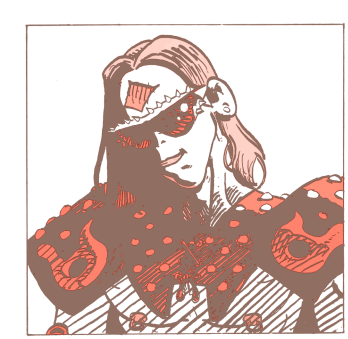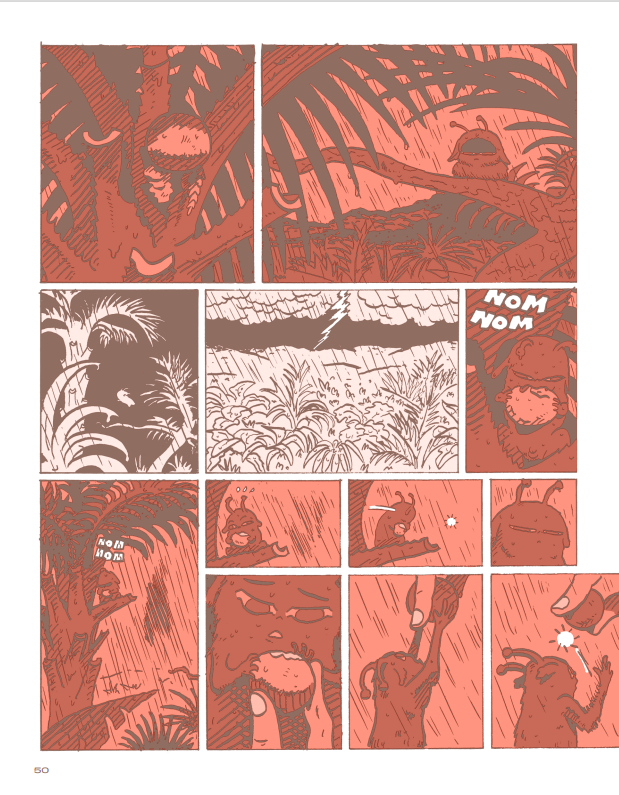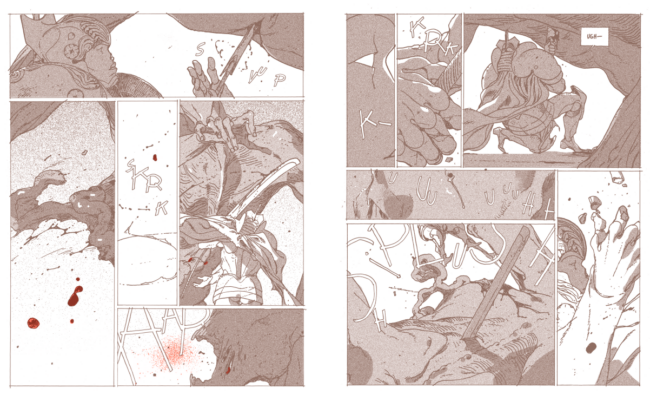PEOW Studio closes its three-volume, genre-spotlight series, Ex.Mag, by focusing on “dark fantasy,” a story filter akin to Game of Thrones, full of swords and bad times. “We just thought it would be cool to see some of our favorite artists draw knights,” series editor Wren McDonald writes in the foreword, and I guess that’s enough of a reason, as any, to publish an anthology.
What to say? In concept, cartoonists of varying skill and prominence creating genre fiction is enticing, and I like looking at it, overall. I especially really like looking at certain parts of it. The soul of this collection is inside the design, and some of the page layouts. Certain artists’ lines carry it, too, as does the underlying feeling that the creators involved possess a personal bond.
But the stories themselves either invite attention or encourage browsing. It’s an anthology! This isn’t an excuse; it just signifies that Ex.Mag #3 would benefit from a more precise and particular vision or purpose beyond “our favorite artists draw knights.” The book could sing! It could say something, anything, by way of distilling each contribution into a smooth aggregate. Or, at the least, it could provide something truly satisfying, page-to-page-to-page, instead of the hits and misses I experienced.
“Magus” by Al Gofa bored me, for example. Its page compositions, energized and alive in their small panels, always-changing layouts, and the quick rhythms they both imply, are the saving grace. The story does not match, however. About two enemy factions, in which a member of one decides to help heal a bedridden member of the other, “Magus” straddles the line between intrigue and goofiness, yet it fails to engage that tonal setup beyond a basic description of it.
Instead, the characters spend a lot of time in their politics, away in quiet chambers or garden grounds, whispering, telling one another they’re having thoughts, so many thoughts. There’s little at stake in this, even though there could be. The story portrays a paranoid group of feudal warriors suspicious of a wizard (named Master Uromorith Ehitrix Iraxaryl the IV) for his decision to tend to their dying friend, but it doesn’t allow the group’s reservations to bloom or explode into momentum, or specific detail, or a reason to care. Their superstition is kept to blatant distrust devoid of texture, and the characters blur into separate, though indistinguishable drawings.
Maybe this is to say something of what little thought tribes place into the reasons for their rivalries, preferring, rather, to forget where their respective hate was born? Maybe the lack of personality or specificity or actual character in Gofa’s cast compliments this point? If so, though, wouldn’t this theme encourage a storyteller to counteract the lack of characterization with something living? To show the reader through juxtaposition? Or, at the least, lend this plot grit worth chewing through?
“Magus” is not that kind of comic. The warriors just keep talking. And at one point, they partake in brief, stylized violence that’s more of an homage to Dragon Ball Z than a hot-blooded story beat. This engagement leads to further of the same, paranoid discussion until the wizard leaves town, and their friend awakes from his coma. That’s the final panel. That’s the core of the story! But I do not know who this man is, or why his survival should matter. I just know he’s back, and the story’s finished.
I came away from “Magus” only aware of its aesthetic concerns. Its concerns of blending the author’s favorite action-oriented influences together to tell a specific genre story, to say of itself, “look how novel, look how hip!” Ex.Mag is preoccupied in this way. It seems content to exude a vibe. It’s the indie comics genre magazine, after all. And that’s notable, impressionistic — even fulfilling enough when taken into account as a printed, browsable art object. Plus, you get good panels, here and there (see below). But why not exist as a complete offering in attitude and substance?
 Linnea Sterte’s “An Arrow for the King” also frustrates, though I’m more forgiving. I’d even call it a good comic. Her drawings, down to the line, are a joy because they exhale an atmosphere. They look at you as you look at them, and they seem summoned from an aging process, or an actual study of an actual scene, like this artist really wants to translate what they see, so you see it, too. This, and Sterte’s decision making — how she sequences what’s happening, the violence that occurs, the way characters look and speak to one another, the positioning of their gazes and postures — deliver a short story that, even though somewhat obtuse and abstracted, still convinces a reader to slow down and breathe it in.
Linnea Sterte’s “An Arrow for the King” also frustrates, though I’m more forgiving. I’d even call it a good comic. Her drawings, down to the line, are a joy because they exhale an atmosphere. They look at you as you look at them, and they seem summoned from an aging process, or an actual study of an actual scene, like this artist really wants to translate what they see, so you see it, too. This, and Sterte’s decision making — how she sequences what’s happening, the violence that occurs, the way characters look and speak to one another, the positioning of their gazes and postures — deliver a short story that, even though somewhat obtuse and abstracted, still convinces a reader to slow down and breathe it in.
Everything is here, really. But it’s the brevity of the story, its limitation in page length, that confines it to poetics and subtle shifts in the narrative. While her hints of worldbuilding suggest a need to expand upon what she’s creating. In a way, I can’t really fault Sterte, as it seems more the case she is working as best she can within the venue provided. Her ability as a writer is just not yet adept enough for a challenge like this, wherein a storyteller must juggle so many pieces at such pace in short fashion, delivering satisfaction or question or takeaway. All that said, “An Arrow for the King” outdoes “Magus” in the department of vibe. I left this story not only interested in Sterte’s study of Moebius, but interested in her own point of view and what her drawings can tell me of it.
Lastly, there is “The Gargoyle Temple” from Hanna K. The best of this collection. It adds a bit of dimension to the issue’s theme of “dark fantasy.”
In it, a woman visits a temple and masturbates before a gargoyle. She’ll be married sometime soon. The fiance isn’t around, and the statue smiles as she pays it one last visit. It’s pleased she’s not handing up another boring prayer, as others of their world do. And I enjoy how bleak and sweet this is.
Like, how two opposing sensations can snap the stale air loose and refresh. Because the gargoyle is not kind, and the woman panics before turning curious, and both leave the scene further complicated but alive. I read this comic and believe the artist responsible leaves something real, something human on the page. Something not so easy to understand. And I walk away with respect because she trusts me to just make sense of it.
The story’s visual style, almost cute, and the main character drawn round and youthful, bright eyed, trick the reader initially before queuing us to turn our heads and mumble, “what the fuck.” But more so than a matter of shock, we wonder what else this relationship between bride-to-be and stone creature is, and why it is, and how the power dynamic inherent in it reflects something we see in our own experience of the world, sexual or not. Perhaps religious.
Hanna K, the storyteller, displays her intelligence not by providing any exact explanations for the questions given airtime, but by simply introducing us to them, in an effective manner, then leaving us where we sit, out here in the hills or wherever you read such a thing, to write our own reviews, or takedowns. She’s confident enough to know she has the reader where she wants them. Rather than draw knights, Hanna K draws what she wants.










